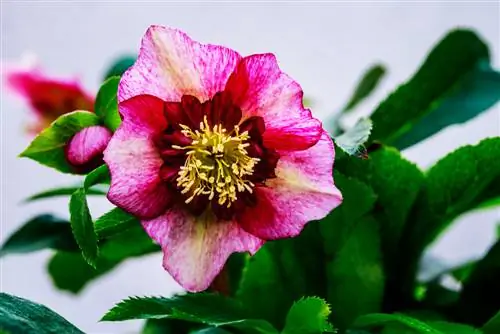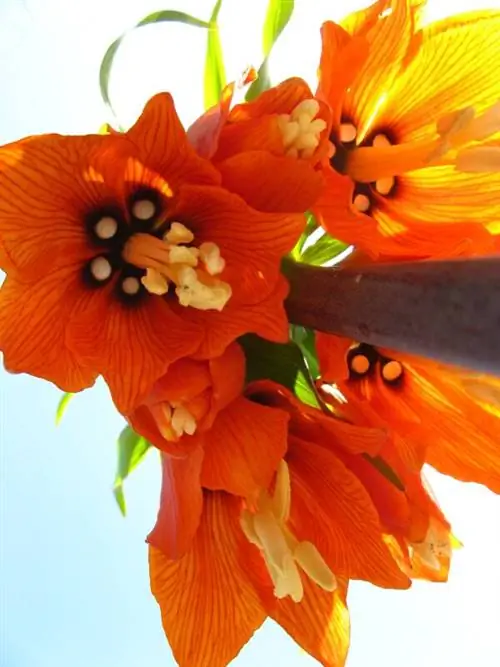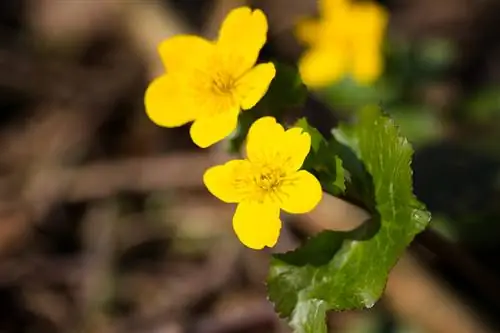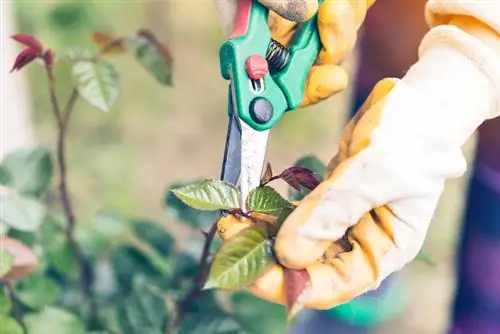- Author admin [email protected].
- Public 2023-12-25 17:45.
- Last modified 2025-01-23 11:21.
Lenzenroses are true miracles. They bloom when other plants are still dormant. If you provide the wintergreen plant with an ideal location, you can enjoy its blooms for several decades.

What are the characteristics and care requirements of the Lenten rose?
The Lenten rose, also known as Helleborus x hybridus, is a wintergreen perennial that blooms in winter and grows up to 50 cm high. It prefers a partially shaded location and humus-rich, well-drained soil. Propagation is possible by seeds or division of the adult plant.
Origin
The spring rose has the scientific name Helleborus x hybridus and is often referred to as oriental hellebore (Helleborus orientalis). This name is misleading because the lentil rose was created from crosses between the oriental hellebore and other species from the genus.
The name of the parent species Helleborus orientalis indicates the plant's natural distribution area. Their area extends from southeastern Europe across the Balkans to the Black Sea. It grows in Turkey and the Caucasus. In Germany the oriental hellebore occurs partly wild. There are some wild stands in Grabfeld, Baden-Württemberg near Pforzheim and in Langenburg.
Growth
Helleborus hybrids grow as wintergreen perennials. Their growth is slow. They reach heights of up to 50 centimeters. Spring roses are considered to be particularly long-lasting.
They have developed a special adaptation to the cold winter months. As soon as temperatures drop below freezing, the plants lower their cell pressure. This causes the leaves and stems to lay flat on the ground and appear wilted. This mechanism protects the plants from freezing. As soon as the temperatures rise again, the plants straighten up.
The parent species Helleborus orientalis is a non-stem-forming species. As the seedling grows, the main root dies. Every year the plant develops fresh side shoots on the rootstock, which form numerous fine roots. The old roots are thickened and fleshy. They are brown to black in color. This growth enables reproduction through division.
Bloom
Lenzenroses develop terminal flowers, which are special from a botanical point of view. It is not the petals that are strikingly colored, but rather the sepals appear in different colors. This means they no longer take on the original protective function. They serve to attract potential pollinators. Each flower consists of five sepals and develops a diameter of up to ten centimeters. The sepals remain until the seeds have ripened.
Over the course of evolution, the flower bracts have transformed into short bag-shaped flower organs that produce nectar. Spring roses develop between five and 20 of these so-called nectaries, which provide food for the few insects at this time of year. The flower is otherwise unspecialized so that it is visited and pollinated by as many insects as possible. Some varieties cannot be fertilized because they form double flowers. The drooping flowers are typical of Helleborus species.
Flower color
Its base is colored green. Spring roses shine in different colors. The palette ranges from white to creamy yellow to pink and black-red. There are some varieties that produce white flowers with colored markings.
Flowering time
These plants open their flowers in winter. Depending on the weather, the first flowers appear in February or earlier. After they are fertilized, the petals turn green.read more
Fruit
Helleborus hybrids develop as many follicles as the number of ovaries that have been fertilized. After successful pollination, nectaries and stamens fall off. When the seeds are fully ripe, the follicles burst open along a pre-formed seam and release the seeds.
Seeds
The tiny seeds are black in color and have a shiny surface. Their shape is bean-shaped and elongated. They turn a dull brown color as the seed coat dries out. A follicle fruit contains between ten and 20 seeds.
leaves
Lendar roses have leathery leaves that are arranged basally. The leaf blade is fingered and is composed of five to eleven leaf lobes. They are arranged in a fan-like manner and appear inverted ovoid or lanceolate. Its edge is double sawn.
When the leaves emerge, they are light green in color. Over the course of the summer the color changes to a dark green. The old foliage dies off as soon as the young leaves appear.
Usage
The unusual flowering period of the Lenten rose makes it a decorative plant for designing spring beds. They are one of the plants that start the growing season. At this time, most of nature is still in hibernation. Lenten roses decorate clearly visible beds, which are dominated by typical summer flowers throughout the year.
Helleborus hybrids are also suitable for planting in containers that decorate balconies, terraces and entrance areas. Spring roses beautify interiors and window sills as cut flowers when the vase is placed in a cool place. You can extend the shelf life by scoring the side of the stems at the bottom.
Ideal planting partners:
- Conifers
- Skimmien
- Fan maples
- Lung herbs
Is Lentenrose poisonous?
The Lenten rose is considered highly poisonous in all parts of the plant. It contains the heart-active saponin helleborin and protoanemonin. The concentration of poisons is highest in the rootstock. Various symptoms of poisoning can occur after consumption. The symptoms range from nausea and dizziness to diarrhea, inflammation of the oral mucosa and cardiac arrhythmias. Consuming large quantities leads to respiratory paralysis, which can be fatal.
Three mature seed capsules are enough to cause severe symptoms of poisoning. The plant sap has skin-irritating effects. You should therefore only plant the plant with caution if pets or children play in your garden.read more
Which location is suitable?
Lentrose roses prefer a partially shaded location under large deciduous trees and bushes. They can be planted in full sun if the soil moisture is sufficiently high. Once the plants have found the right location, they will return again and again for decades. The soil should not tend to become waterlogged.read more
What soil does the plant need?
A fresh substrate that ensures high permeability is ideal. Spring roses feel comfortable on very humus-rich loamy soils. If the soil is very light and sandy, you can improve the structure and nutrient content by incorporating dolomite lime, bark humus and horn shavings. Crushed eggshells are recommended as an alternative to dolomite lime. Spring roses thrive when the soil is calcareous. Spring roses also grow well on acidic soils.
Propagate Lentenrose
Adult plants can be propagated by division, but the yield of viable plants is low. Spring roses then require a lot of time and good care so that they grow back into stately plants. If you want to divide your plant, choose an overcast day in the fall. Spring is not suitable for this measure as the plant blooms very early.
To avoid unnecessary injuries when doing this, you should tie the stems and leaves together with a ribbon. Cut off as large a root ball as possible and dig it out. Pierce the middle of the root ball with a digging fork. Attach another pitchfork and carefully move both garden tools apart. This causes the rhizome to split open until two separate plants are formed. If your spring rose is a little smaller, you can divide the rhizome with a knife.
How to proceed after sharing:
- Plant sections immediately so that roots do not dry out
- water thoroughly so that the rootstock is moistened ten to 15 centimeters deep
- remove damaged leaves to prevent disease
Sowing
It can take between three and four years for a plant to bloom for the first time. If the plant has successfully developed fruit, you can propagate your Lenten rose by seeds. These offspring are often less flowery than their parent plant.
Collect the fruits immediately after they ripen. You can recognize ripe fruits by their yellow-green color. At this point they open easily so you can release the seeds from their capsules. Clean the seeds and let them dry. If you sow the seeds in the fall, they will begin germinating in November.
Lenzrose in a pot
Lendar roses grow slowly, but can take up a lot of space over the course of their life. If you want to cultivate the plant in a pot, you should take into account the large amount of space required. Rejuvenate the plant every two to three years so that its magnificent growth does not become stunted due to lack of space.
Choose a thick-walled container that offers sufficient protection from frost. Alternatively, you can wrap the pot with bubble wrap or garden fleece to prevent the rootstock from freezing.
Use a mixture of potting soil and as high a proportion of humus as possible as a substrate. You can also use potting soil with a small amount of peat. The Lentenrose is less suitable as a houseplant. It also prefers an outdoor location in a pot.
Watering Lentenrose
The Lenten rose likes permanently moist conditions in the substrate. It survives short periods of drought, but reacts to this with reduced flowering. As soon as the top layer of soil has dried, you should water the plant.
You can check the moisture in the substrate with the finger test (€39.00 on Amazon). If the soil feels dry and crumbly, the Lenten rose needs fresh water. During summer droughts, you should check moisture levels several times a day. Spring roses tolerate water with small amounts of lime. Waterlogging should be avoided as it leads to root rot.
Fertilize Lenten rose properly
Helleborus hybrids are considered to have low consumption. To support their vitality, you can fertilize occasionally. If the plant is about to flower, it will enjoy a compost addition or fertilization with rock dust. Between February and May you can use a liquid fertilizer if necessary.
In autumn you can spread brushwood, bark mulch or withered leaves on the ground. This layer acts as a cold protection for young plants and supplies the plant with nutrients the next spring when the soil organisms have decomposed the material. If your spring rose grows on sandy soil, you can spread some algae lime on the substrate in autumn.
Cut the Lenten rose correctly
After winter, withered leaves are removed. Be careful with this care measure so that you do not damage the newly sprouting parts of the plant. Brown or black leaves should be cut off immediately to prevent disease from spreading. After flowering, it is recommended to cut off the ripening fruit stalks.read more
How do I transplant correctly?
Lengen roses develop a strong rootstock that reaches deeper into the earth as it gets older. Therefore, when transplanting, there is a risk of damaging many roots. In the new location, the plant has difficulty developing the stately growth that it showed in the old place of growth. It requires a high degree of horticultural sensitivity until the Lenten rose has recovered after being transplanted.
hardy
Young specimens need winter protection. Add a layer of compost or bark mulch to the ground. Full-grown Lenten roses are hardy. The early-flowering species survive the winter without any problems. For older plants, mulching provides nutrients in the coming spring.
If the thermometer drops below -15 degrees Celsius, the leaves die. They turn black and look unsightly. This doesn't cause any problems for the plant. It sprouts again shortly before flowering. The plant must be watered on frost-free days because the metabolism does not stop completely even in winter.
How to protect potted plants:
- Wrap the planter with burlap, fleece or foil in October
- Place the bucket on a Styrofoam plate
- water on frost-free days
Diseases
The winter bloomers rarely fall victim to the viral disease Black Death, which is fatal. After infection, the veins on leaves and flowers turn black. Countermeasures are not known. To avoid spreading, you should remove the plant completely and dispose of it with household waste.
Pests
Lengen roses are attacked by a number of pests that spread under certain conditions. The pests weaken the plants, so quick action is necessary.
Aphids
Lenger roses are often attacked by aphids. The pests suck the sap from the leaves of winter bloomers. They prefer to spread on fresh leaves and young plants. Wipe the aphids off the plant parts regularly. For this measure, use a cloth soaked in detergent. Nettle decoction strengthens the vitality of the plant and has a preventive effect against the spread of aphids. If there is an infestation, you can spray the entire plant with the decoction.
Root nematodes
If the plant tends to have stunted growth that does not subside even after changing the care, root nematodes may be the cause. The microscopic nematodes suck nutrients from the fine roots so that they can no longer supply the plant. Controlling the pests is difficult. Discard infected plants so that the pests cannot spread.
Tip
Varieties with clearly defined characteristics are rarely found. Plants propagated generatively via seeds are predominantly offered on the market. They leave only one guess as to which characteristics they have inherited from their parent plants. That's why you'll always find new beauties without names.
Varieties
- Spring Promise(R) Elly?: Particularly early-flowering variety with double flowers. Flower color pink.
- Winter Angels Anna’s Red: Purple flowers. Blooms from December to April.
- Winter Angels Claudia: White flowers with red to purple dot markings.






